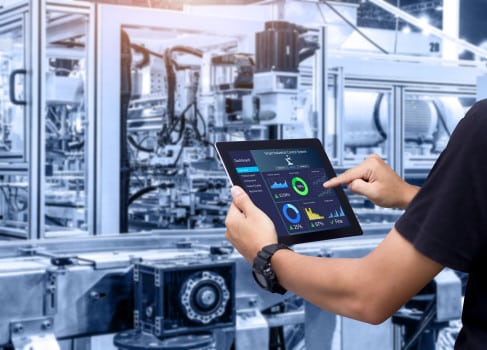What is Industrial Automation?
Industrial automation concerns the use of products, such as computers or robots, and information technologies to manage industrial machinery and processes. This field focuses on increasing the efficiency, productivity and quality of production while reducing costs, waste and safety risks. In the era of Industry 4.0, industrial automation therefore plays a crucial role in the transformation of manufacturing processes.
Features of industrial automation
INCREASED EFFICIENCY AND PRODUCTIVITY
Industrial automation enables efficient optimization of operations. By reducing dependence on manual labor and introducing automated machines and systems, companies can increase the speed of production, reduce human error and improve the use of available resources. Automated machines can work continuously non-stop, enabling companies to make the most of their working hours and increase productivity.
IMPROVED QUALITY AND ACCURACY
With automation, greater precision and quality can be ensured in production processes. Automated systems perform repetitive operations consistently, without fatigue or distraction. This reduces human error and increases the consistency of results. Automation also allows processes to be monitored and controlled in real time, with the ability to make immediate changes and corrections if necessary.
SAFETY AND RISK REDUCTION
Industrial automation also helps improve workplace safety. Human operators may be exposed to hazardous working conditions or hazards from high-intensity repetitive tasks. By incorporating automated machines, operators’ exposure to hazardous situations can be minimized, improving overall safety. In addition, automation systems can be designed to monitor and control emergency situations quickly and efficiently.
INNOVATION AND ADOPTION OF NEW TECHNOLOGIES
Industrial automation allows new technologies to be leveraged more effectively. The integration of sensors, smart devices, data analytics and artificial intelligence enables companies to collect real-time data, analyze it and derive valuable information to make better decisions. Automation also offers greater flexibility, allowing companies to adapt quickly to changes in the market or new customer needs.
Industrial automation has thus become a key component of business success. It ensures greater efficiency, productivity, quality and safety at work, enabling companies to remain competitive in the Industry 4.0 era. Investing in industrial automation means embracing innovation and preparing for the future in an increasingly connected and technological world.
How industrial automation works
Elmak stands out in the field of industrial automation because of its extensive experience and a team that has been able to provide concrete answers to the needs of a rapidly changing market.
The company has not only followed technology trends but has applied innovative solutions that integrate automation with the latest developments in IT. This proactive approach has enabled Elmak to offer its customers state-of-the-art automation solutions that not only meet but often exceed market expectations in terms of performance, efficiency, and adaptability.
Elmak’s products, such as Panel PCs, Fanless PCs, and various display and control devices, are critical in the field of industrial automation. Here are some examples of how some of the products can be used
Using Elmak’s Panel PCs:
Centralized Control: Elmak’s Panel PCs are installed along the assembly line to provide an intuitive user interface for machine control. Operators can monitor and adjust assembly parameters such as line speed, temperature and other critical variables.
Touchscreen interface: With their touchscreen functionality, Panel PCs make it easier for operators to interact with the system, allowing quick access to critical functions and improving operational efficiency.
Application of Elmak’s Fanless PCs:
- Dusty Environments: Elmak’s Fanless PCs, which have no moving parts such as fans, are ideal for dusty environments such as an electronics factory. This reduces the risk of malfunction due to the accumulation of dust and dirt.
- Reliability and Durability: Their robust construction and resistance to temperature variations make them suitable for continuous operation without failure, ensuring uninterrupted production.
Use of Display and Control Devices:
Real-Time Monitoring: Display devices provide real-time feedback on production progress. For example, monitors placed at strategic locations display real-time data such as production output and maintenance alerts.
Precision Control: Control devices enable operators to make fine adjustments to machinery, improving the quality of the final product and reducing waste.
